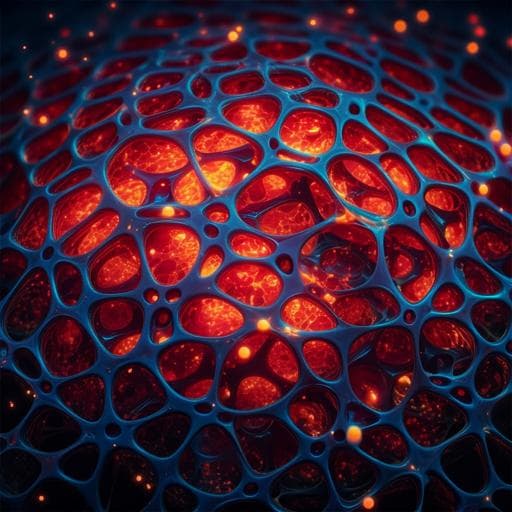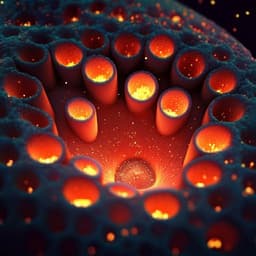
Engineering and Technology
Nitrogen-enriched graphene framework from a large-scale magnesiothermic conversion of CO₂ with synergistic kinetics for high-power lithium-ion capacitors
C. Li, X. Zhang, et al.
Discover the groundbreaking nitrogen-enriched graphene framework (NGF) designed by Chen Li and colleagues, showcasing unmatched lithium storage capabilities and exceptional electrical conductivity. This innovative NGF holds promise for high-power applications, exemplified by a lithium-ion capacitor achieving impressive energy densities. Join us in exploring this revolutionary advancement in energy storage technology!
~3 min • Beginner • English
Introduction
The global demand for sustainable high-power energy-storage systems is rising as traditional fossil fuels are rapidly consumed. While lithium-ion batteries (LIBs) provide high energy density (>200 Wh kg⁻¹), their power density is low (<1 kW kg⁻¹). Supercapacitors (SCs) offer high power but low energy density (<15 Wh kg⁻¹). Lithium-ion capacitors (LICs) have emerged to bridge this gap by combining battery-type anodes and capacitor-type cathodes in organic electrolytes. A key challenge is the kinetic imbalance between fast capacitive cathodes and slower faradaic anodes limited by sluggish Li transport within the bulk. Strategies to resolve this include developing anode materials with pseudocapacitive behavior (alloys, conversion, and intercalation materials). However, alloy and conversion anodes suffer from large volume changes and poor rate/cycling stability, and intercalation anodes have limited Li⁺ storage. Graphene is promising as an anode due to high surface area, conductivity, and stability, but pristine defect-free graphene hampers Li stabilization and diffusion, limiting high-rate performance and cycling. Enhancing both electron transport and ion diffusion via structural engineering (porosity) and surface chemistry (heteroatom doping) is crucial. Porous graphene can increase active sites and shorten diffusion pathways, while nitrogen doping introduces active sites and pseudocapacitive behavior through charge polarization. Prior N-doped graphene demonstrations improved capacity and cycling but often required complex, energy-intensive syntheses (e.g., solvothermal/annealing of GO or CVD). Combustion synthesis (CS) offers ultrafast, high-temperature, scalable production with high purity and crystallinity, yet simultaneous porosity regulation and surface engineering are challenging at such temperatures. This work proposes a large-scale, controllable, low-cost magnesiothermic CS using CO₂ (carbon source) and melamine (nitrogen source) to produce nitrogen-enriched graphene frameworks (NGFs) with crosslinked mesoporosity and abundant N functionalities to synergistically enhance electron/ion transport for high-power LICs.
Literature Review
- Anode materials with pseudocapacitive behavior have been explored to overcome kinetic desynchronization in LICs, including alloys (Si, Sn-based), conversion materials (MnO₂, VN, MoS₂, Fe₃O₄), and intercalation materials (Li₄Ti₅O₁₂, V₂O₅, TiO₂, Nb₂O₅). Alloys/conversion anodes suffer from large volume change and fast fade; intercalation anodes have low capacity.
- Graphene was initially reported to deliver 580–650 mAh g⁻¹ due to Li anchoring on both sides/edges but later studies showed difficulty stabilizing/diffusing Li in defect-free graphene, hindering rate and cycling.
- Porous/holey graphene with micro/mesopores enhances active site availability, ion diffusion, and rate performance: e.g., porous graphene nanosheets achieved 1040 mAh g⁻¹ at 0.1 A g⁻¹; graphene aerogels from GO reached ~1100 mAh g⁻¹ via hydrothermal methods.
- Heteroatom doping (N, S, P, B) improves conductivity, wettability, surface reactions, and Li storage rates. Nitrogen doping is particularly effective: electronegativity differences polarize carbon, creating active sites, modifying spin density and charge distribution to catalyze surface reactions.
- Reported N-doped graphene (NG) examples: CVD NG (≈9 at.% N) doubled capacity over pristine graphene; NH₃/annealing or ammonia treatments yielded NG with reversible capacities up to 872–900 mAh g⁻¹ and stable cycling; holey NG monolith achieved high volumetric capacity (1052 mAh cm⁻³). However, most methods rely on solvothermal/annealing of GO or high-temperature CVD with metal catalysts, complicating fabrication and increasing energy consumption.
- Combustion synthesis provides ultrafast, high-temperature, scalable routes with self-purification but has not been applied to engineer both porosity and surface chemistry simultaneously for graphene; the present work addresses this gap using magnesiothermic CS with CO₂ and melamine.
Methodology
Synthesis of NGFs: A magnesiothermic combustion synthesis (CS) was performed using CO₂ gas as the carbon source and melamine (C₃H₆N₆) as the nitrogen source. A mixture of 40 g Mg powder (500 mesh), 8 g melamine (analytical grade), and 200 g MgO powder (300 mesh, serving as a hard template) was placed in a 20 L reaction chamber. The chamber was evacuated and purged with CO₂ three times to remove oxygen, then pressurized to 1 MPa with CO₂. A tungsten coil embedded in the mixture was resistively heated to initiate self-sustaining combustion. Post-reaction, the product was washed with diluted HCl to remove MgO, thoroughly rinsed with deionized water, and freeze-dried to obtain NGF-2. To vary N-doping, melamine was adjusted to 3 g (NGF-1) or 15 g (NGF-3) with other parameters fixed. A melamine-free control (NGF-0) was also synthesized. Reaction chemistry: CO₂ + 2Mg → C (graphene) + 2MgO (template).
Characterization: Morphology by SEM (Hitachi S-4800, 20 kV) and TEM (JEOL JEM-2100F, 200 kV). XRD (Bruker D8, Cu Kα, λ=1.54060 Å, 5°/min). XPS (PHI Quantear SXM, Al Kα, 1486.6 eV). Raman (Horiba Jobin Yvon HR-800, 532 nm). N₂ adsorption/desorption at 77 K (Micromeritics ASAP 2020) for BET surface area and DFT pore size distribution. Electrical conductivity: pellets pressed at 6 MPa to 320 μm thickness and measured by four-probe. TGA (Netzsch TG 209 F3, 5 K min⁻¹) in N₂ and air from 50–800 °C.
Electrode fabrication and cells: Electrodes prepared with 80 wt% active material, 10 wt% acetylene black, 10 wt% PVDF in NMP; coated on Cu (anode) or Al (cathode), dried at 120 °C (12 h), and punched to 13 mm disks. Half-cells: 2032 coin cells with Li foil counter/reference, Celgard 2400 separator, electrolyte 1 M LiPF₆ in EC/DEC/DMC (1:1:1 v/v/v). Average mass loading ~2 mg cm⁻². Full-cell LIC: soft-packaged all-graphene device using NGFs as both cathode and anode; cathode/anode mass ratio tuned (1:1 to 4:1). Anode prelithiated (0.03–3 V, 0.1 A g⁻¹, 5 cycles). Cells aged 24 h before testing.
Electrochemical testing: CV, GCD, and EIS (BioLogic VMP3). Cycling stability (Arbin MSTAT4). EIS from 100 mHz to 100 kHz, 10 mV amplitude. LIC capacitance computed from discharge curves: C = It/[m(Vmax − Vmin)]; energy E = 1/2 C (Vmax² − Vmin²); power P = E/t.
Computations: DFT with VASP using PAW and GGA-PBE. Plane-wave cutoff 550 eV. Convergence: 1×10⁻⁵ eV/atom (ionic), forces <0.03 eV Å⁻¹; electronic convergence 1×10⁻⁶ eV/atom. Model: 4×4×1 graphene supercell (18 C atoms), 20 Å vacuum; k-point meshes: 5×5×1 (optimization), 9×9×1 (energy), 12×12×1 (DOS).
Key Findings
- Nitrogen-enriched graphene frameworks (NGFs) produced via large-scale, ultrafast magnesiothermic combustion using CO₂ and melamine exhibit crosslinked porous structures with abundant N functional groups and high electrical conductivity (10524 S m⁻¹).
- High-rate lithium storage: specific capacities of 1361 mAh g⁻¹ at 0.1 A g⁻¹ and 827 mAh g⁻¹ at 3 A g⁻¹, indicating excellent performance at both low and high current densities.
- LIC device performance: energy density of 151 Wh kg⁻¹; retains 86 Wh kg⁻¹ at ultrahigh power density of 49 kW kg⁻¹.
- Morphology: SEM/TEM reveal continuously crosslinked, porous graphene frameworks with well-defined edges, ripples, and crumples; uniform N distribution throughout frameworks.
- Scalability demonstrated with an ~80 g NGF-2 product batch, indicating feasible, cost-effective, and eco-friendly mass production.
- Structural/crystallinity improvements with melamine: XRD shows stronger (002) peak at 25.7° and (100) at 43° for N-doped samples; decreased FWHM of (002) from NGF-1 to NGF-3 indicates enhanced crystallinity and conductivity. Raman IG/ID increases from 0.94 (NGF-0) to 1.15 (NGF-3), evidencing improved stacking order.
- DFT and kinetics analysis attribute performance to high levels of pyridinic and pyrrolic N, increasing Li adsorption energy and carrier density, thereby enhancing electron transport and surface redox kinetics.
- Porous frameworks with interconnected mesopores shorten Li⁺ diffusion paths and provide abundant charge storage sites, synergizing with improved electronic pathways for superior rate capability.
Discussion
The study targets the kinetic mismatch in LICs by engineering a graphene-based anode material that simultaneously enhances electronic conductivity and ionic transport. The magnesiothermic combustion approach using CO₂ and melamine yields NGFs with crosslinked mesoporosity, ensuring interconnected ion pathways and large accessible surface area for fast Li⁺ transport. Nitrogen doping, particularly pyridinic and pyrrolic configurations, polarizes adjacent carbon atoms to create active sites, elevating carrier density and facilitating surface redox reactions. Together, these features enable high capacities at both low and high rates and excellent power performance in full LICs. XRD and Raman confirm improved graphitization and stacking order, consistent with measured high conductivity. The resultant LICs deliver high energy density and maintain substantial energy at ultrahigh power, demonstrating effective mitigation of the cathode–anode kinetic imbalance and validating the synergistic design of porosity and heteroatom doping in graphene frameworks.
Conclusion
This work introduces a scalable, low-cost magnesiothermic combustion synthesis that converts CO₂ into nitrogen-enriched graphene frameworks using melamine as the nitrogen source. The resulting NGFs combine crosslinked mesoporosity with abundant N functionalities, delivering high electrical conductivity, fast ion diffusion, and numerous active sites. These synergistic attributes enable high specific capacities (up to 1361 mAh g⁻¹), outstanding rate performance (827 mAh g⁻¹ at 3 A g⁻¹), and high LIC device metrics (151 Wh kg⁻¹, retaining 86 Wh kg⁻¹ at 49 kW kg⁻¹). The study provides a practical route to engineered graphene with tailored porosity and surface chemistry and deepens understanding of N-doping effects on lithium storage. Future research could optimize N configuration distributions, pore architecture, and electrode/electrolyte interfaces, and explore device-level engineering (e.g., higher mass loadings, thicker electrodes, and alternative electrolytes) to further enhance energy–power trade-offs and cyclability.
Limitations
Related Publications
Explore these studies to deepen your understanding of the subject.







